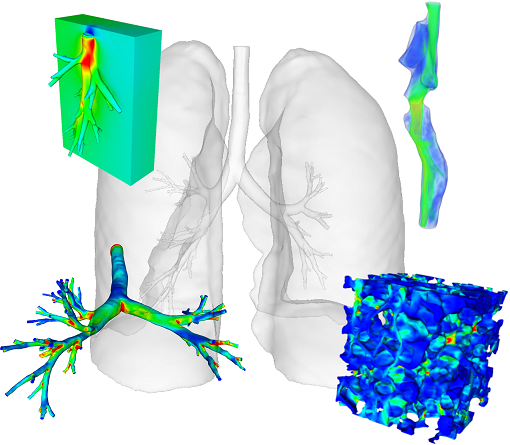Numerische Modellierung der Lunge
Ziel dieses Projektes ist es, die künstliche Beatmung bei Patienten mit akutem Lungenversagen mit Hilfe numerischer Simulationen zu verbessern. Die Simulationen im Bereich der zentralen Atemwege basieren auf aus Computertomographie-Datensätzen gewonnenen Geometrien. Hier wird über sogenannte Fluid-Struktur-Interaktions-Ansätze die gegenseitige Beeinflussung von Luftströmung und Atemwegswanddeformation unter Berücksichtigung des umliegenden Gewebes simuliert. Physiologische Ausflussrandbedingungen am Ende der auflösbaren 3D-Geometrie werden mittels neuartiger Impedanzrandbedingungen realisiert. Hierbei wird der Effekt des unaufgelösten unteren Teils des Atemwegsbaums über eine 1D-Simulation ermittelt und durch einen speziellen 3D-1D-Kopplungsansatz mit dem aufgelösten Atemwegsbaum verbunden.
Coupled Problems in Computational Modeling of the Respiratory System
This project is concerned with computational models of the respiratory system against the background of acute lung diseases and mechanical ventilation. We divide the lung into two major subsystems, namely the conducting airways and the respiratory zone represented by lung parenchyma. Due to their respective complexity, both parts are themselves out of range for a direct numerical simulation resolving all relevant length scales. Therefore, we develop detailed individual models for parts of the subsystems as a basis for novel multi-scale approaches taking into account the unresolved parts appropriately. In the tracheo-bronchial region, CT-based geometries up to a maximum of approximately seven generations are employed in fluid-structure interaction simulations, considering not only airway wall deformability but also the influence of surrounding lung tissue. Physiological outflow boundary conditions are derived by considering the impedance of the unresolved parts of the lung in a fully coupled 3D-1D approach. In the respiratory zone, an ensemble of alveoli representing a single ventilatory unit is modeled considering not only soft tissue behavior but also the influence of the covering surfactant film. Novel nested multi-scale procedures are then employed to simulate the dynamic behavior of lung parenchyma as a whole and local alveolar ensembles simultaneously without resolving the alveolar micro-structure completely.
Michael W. Geegee_AT_lnm.mw.tum.de

